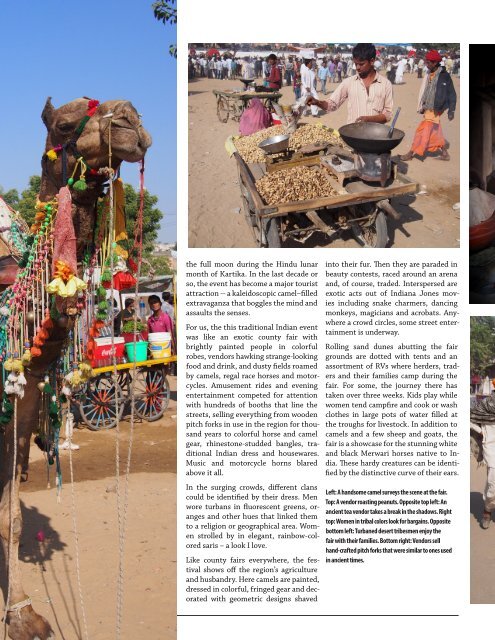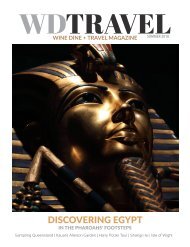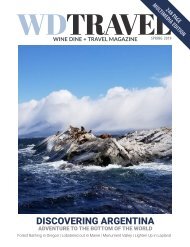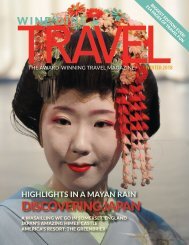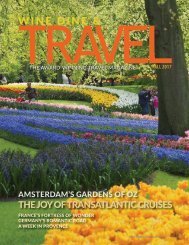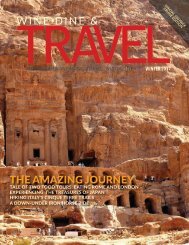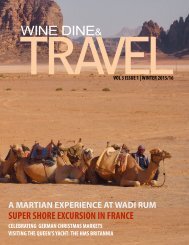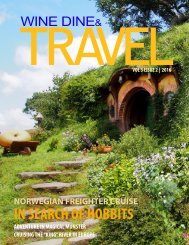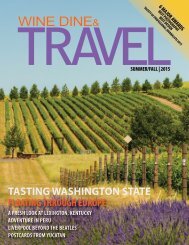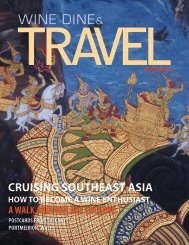WINE DINE & TRAVEL MAGAZINE SPRING 2014
This issue features stories that illustrate a range of emotions. From death on the Ganges River to the joy of renewal in Utah, the stories in this issue are entertaining and thought provoking. WDT takes great pride in our wonderful writers and gives them the rare opportunity these days to write in-depth length stores rich with information, detail and personality. Our many thousands of our readers have come to expect this kind of travel journalism and if you’re reading this, you probably do too. We’ve grown again with this issue, publishing more than 90 pages of solid editorial content. We’ve grown because WDT is fortunate enough to attract some of the very best travel and food writers in the industry. In this issue, the talented writers who have contributed since our inaugural issue last year are joined by some veteran talent making their WDT debut. Among them are two Brits, Mark Moxon and Amy Laughinghouse, evocative writers who can make you laugh out loud or maybe just reflect.
This issue features stories that illustrate a range of emotions. From death on the Ganges River to the joy of renewal in Utah, the stories in this issue are entertaining and thought provoking. WDT takes great pride in our wonderful writers and gives them the rare opportunity these days to write in-depth length stores rich with information, detail and personality. Our many thousands of our readers have come to expect this kind of travel journalism and if you’re reading this, you probably do too. We’ve grown again with this issue, publishing more than 90 pages of solid editorial content. We’ve grown because WDT is fortunate enough to attract some of the very best travel and food writers in the industry. In this issue, the talented writers who have contributed since our inaugural issue last year are joined by some veteran talent making their WDT debut. Among them are two Brits, Mark Moxon and Amy Laughinghouse, evocative writers who can make you laugh out loud or maybe just reflect.
Create successful ePaper yourself
Turn your PDF publications into a flip-book with our unique Google optimized e-Paper software.
the full moon during the Hindu lunar<br />
month of Kartika. In the last decade or<br />
so, the event has become a major tourist<br />
attraction -- a kaleidoscopic camel–filled<br />
extravaganza that boggles the mind and<br />
assaults the senses.<br />
For us, the this traditional Indian event<br />
was like an exotic county fair with<br />
brightly painted people in colorful<br />
robes, vendors hawking strange-looking<br />
food and drink, and dusty fields roamed<br />
by camels, regal race horses and motorcycles.<br />
Amusement rides and evening<br />
entertainment competed for attention<br />
with hundreds of booths that line the<br />
streets, selling everything from wooden<br />
pitch forks in use in the region for thousand<br />
years to colorful horse and camel<br />
gear, rhinestone-studded bangles, traditional<br />
Indian dress and housewares.<br />
Music and motorcycle horns blared<br />
above it all.<br />
In the surging crowds, different clans<br />
could be identified by their dress. Men<br />
wore turbans in fluorescent greens, oranges<br />
and other hues that linked them<br />
to a religion or geographical area. Women<br />
strolled by in elegant, rainbow-colored<br />
saris – a look I love.<br />
Like county fairs everywhere, the festival<br />
shows off the region’s agriculture<br />
and husbandry. Here camels are painted,<br />
dressed in colorful, fringed gear and decorated<br />
with geometric designs shaved<br />
into their fur. Then they are paraded in<br />
beauty contests, raced around an arena<br />
and, of course, traded. Interspersed are<br />
exotic acts out of Indiana Jones movies<br />
including snake charmers, dancing<br />
monkeys, magicians and acrobats. Anywhere<br />
a crowd circles, some street entertainment<br />
is underway.<br />
Rolling sand dunes abutting the fair<br />
grounds are dotted with tents and an<br />
assortment of RVs where herders, traders<br />
and their families camp during the<br />
fair. For some, the journey there has<br />
taken over three weeks. Kids play while<br />
women tend campfire and cook or wash<br />
clothes in large pots of water filled at<br />
the troughs for livestock. In addition to<br />
camels and a few sheep and goats, the<br />
fair is a showcase for the stunning white<br />
and black Merwari horses native to India.<br />
These hardy creatures can be identified<br />
by the distinctive curve of their ears.<br />
Left: A handsome camel surveys the scene at the fair.<br />
Top: A vendor roasting peanuts. Opposite top left: An<br />
ancient tea vendor takes a break in the shadows. Right<br />
top: Women in tribal colors look for bargains. Opposite<br />
bottom left: Turbaned desert tribesmen enjoy the<br />
fair with their families. Bottom right: Vendors sell<br />
hand-crafted pitch forks that were similar to ones used<br />
in ancient times.<br />
14 Wine Dine & Travel Spring <strong>2014</strong>


